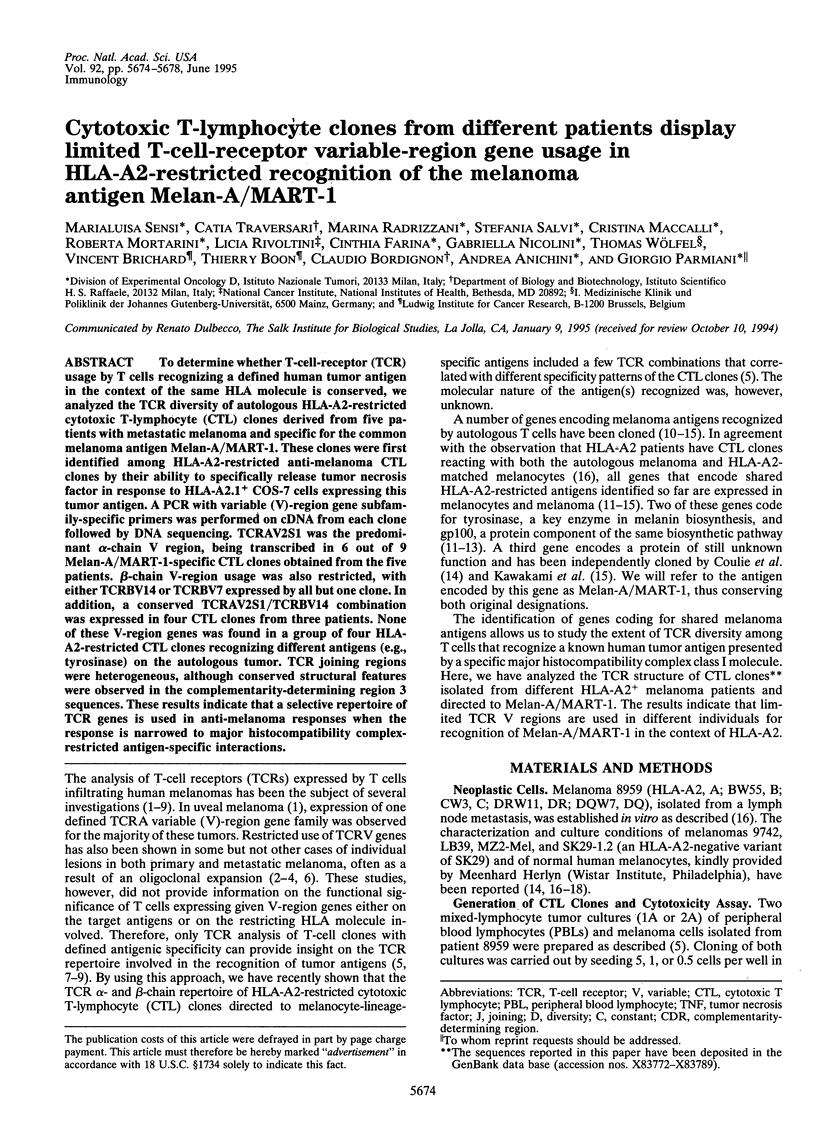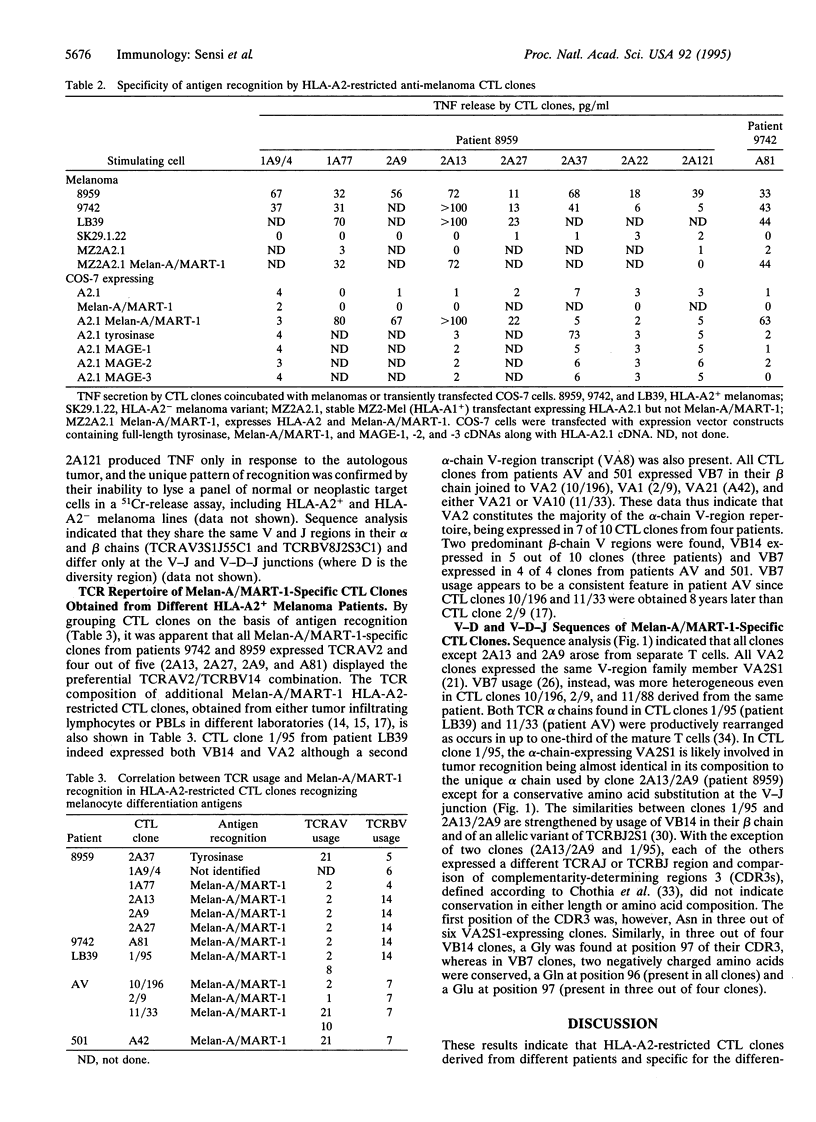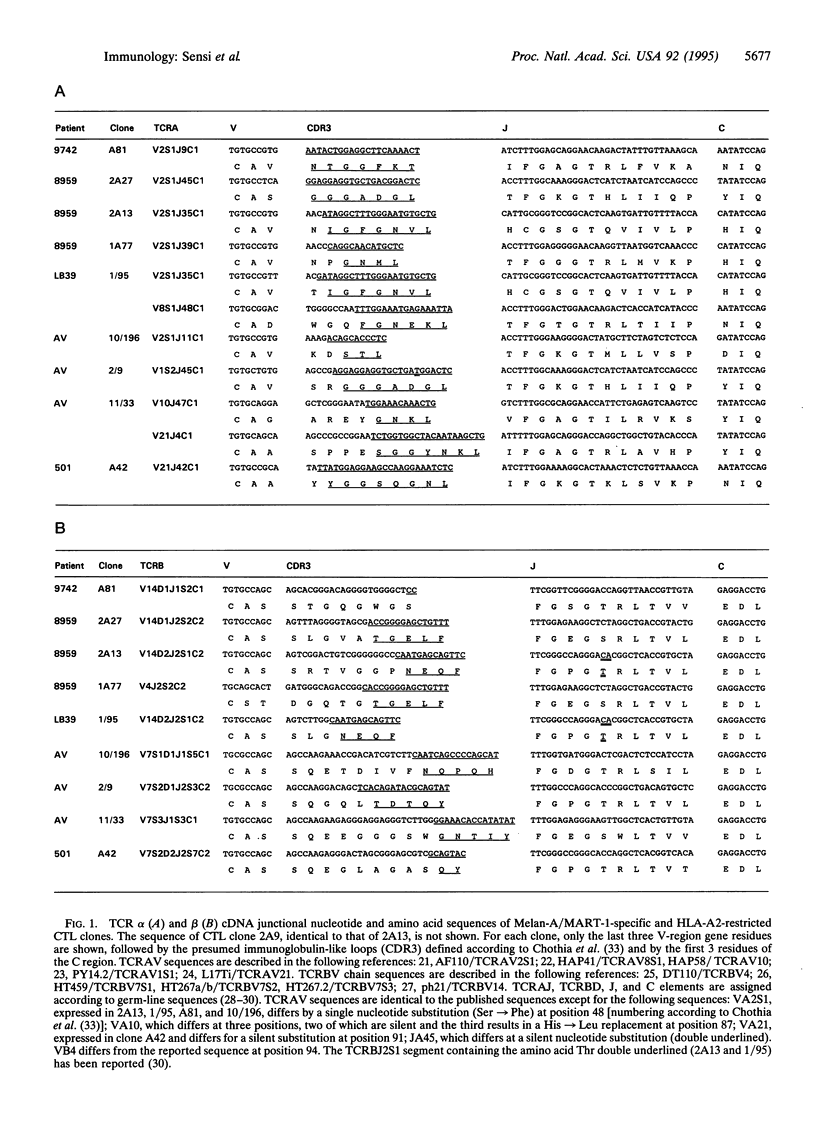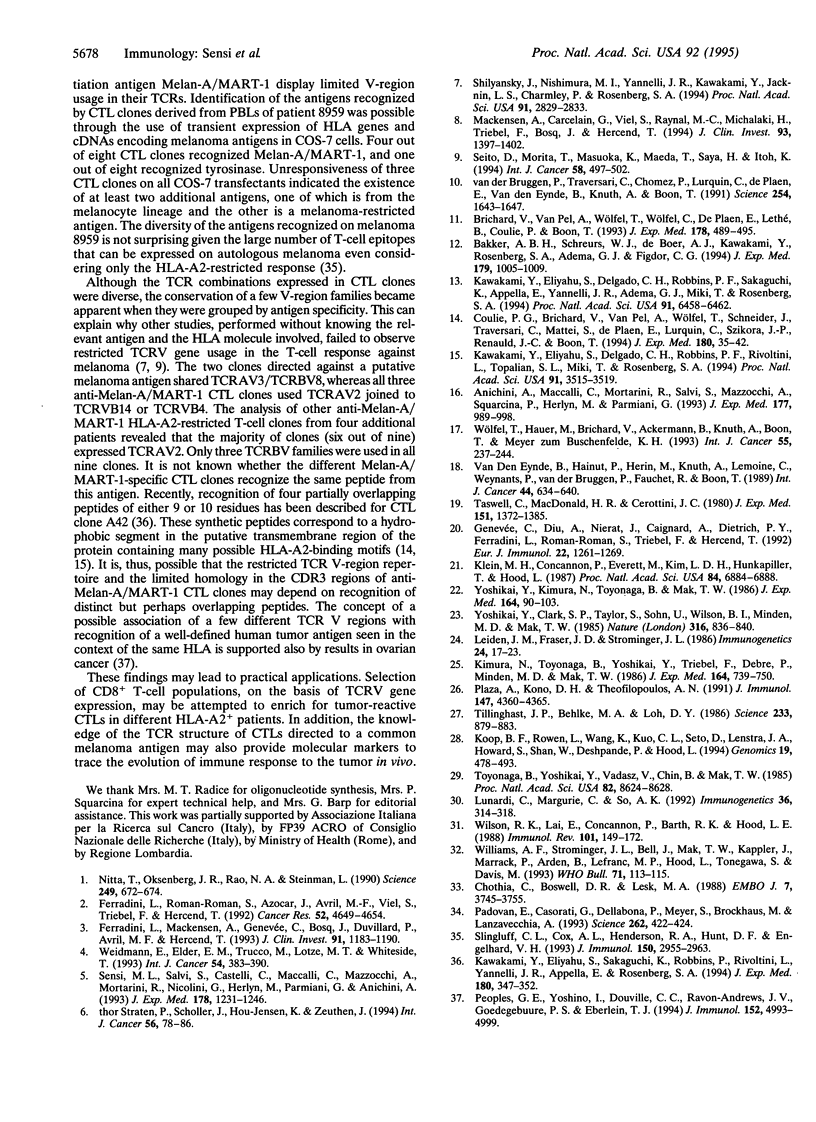Abstract
To determine whether T-cell-receptor (TCR) usage by T cells recognizing a defined human tumor antigen in the context of the same HLA molecule is conserved, we analyzed the TCR diversity of autologous HLA-A2-restricted cytotoxic T-lymphocyte (CTL) clones derived from five patients with metastatic melanoma and specific for the common melanoma antigen Melan-A/MART-1. These clones were first identified among HLA-A2-restricted anti-melanoma CTL clones by their ability to specifically release tumor necrosis factor in response to HLA-A2.1+ COS-7 cells expressing this tumor antigen. A PCR with variable (V)-region gene subfamily-specific primers was performed on cDNA from each clone followed by DNA sequencing. TCRAV2S1 was the predominant alpha-chain V region, being transcribed in 6 out of 9 Melan-A/MART-1-specific CTL clones obtained from the five patients. beta-chain V-region usage was also restricted, with either TCRBV14 or TCRBV7 expressed by all but one clone. In addition, a conserved TCRAV2S1/TCRBV14 combination was expressed in four CTL clones from three patients. None of these V-region genes was found in a group of four HLA-A2-restricted CTL clones recognizing different antigens (e.g., tyrosinase) on the autologous tumor. TCR joining regions were heterogeneous, although conserved structural features were observed in the complementarity-determining region 3 sequences. These results indicate that a selective repertoire of TCR genes is used in anti-melanoma responses when the response is narrowed to major histocompatibility complex-restricted antigen-specific interactions.
Full text
PDF




Selected References
These references are in PubMed. This may not be the complete list of references from this article.
- Anichini A., Maccalli C., Mortarini R., Salvi S., Mazzocchi A., Squarcina P., Herlyn M., Parmiani G. Melanoma cells and normal melanocytes share antigens recognized by HLA-A2-restricted cytotoxic T cell clones from melanoma patients. J Exp Med. 1993 Apr 1;177(4):989–998. doi: 10.1084/jem.177.4.989. [DOI] [PMC free article] [PubMed] [Google Scholar]
- Bakker A. B., Schreurs M. W., de Boer A. J., Kawakami Y., Rosenberg S. A., Adema G. J., Figdor C. G. Melanocyte lineage-specific antigen gp100 is recognized by melanoma-derived tumor-infiltrating lymphocytes. J Exp Med. 1994 Mar 1;179(3):1005–1009. doi: 10.1084/jem.179.3.1005. [DOI] [PMC free article] [PubMed] [Google Scholar]
- Brichard V., Van Pel A., Wölfel T., Wölfel C., De Plaen E., Lethé B., Coulie P., Boon T. The tyrosinase gene codes for an antigen recognized by autologous cytolytic T lymphocytes on HLA-A2 melanomas. J Exp Med. 1993 Aug 1;178(2):489–495. doi: 10.1084/jem.178.2.489. [DOI] [PMC free article] [PubMed] [Google Scholar]
- Chothia C., Boswell D. R., Lesk A. M. The outline structure of the T-cell alpha beta receptor. EMBO J. 1988 Dec 1;7(12):3745–3755. doi: 10.1002/j.1460-2075.1988.tb03258.x. [DOI] [PMC free article] [PubMed] [Google Scholar]
- Coulie P. G., Brichard V., Van Pel A., Wölfel T., Schneider J., Traversari C., Mattei S., De Plaen E., Lurquin C., Szikora J. P. A new gene coding for a differentiation antigen recognized by autologous cytolytic T lymphocytes on HLA-A2 melanomas. J Exp Med. 1994 Jul 1;180(1):35–42. doi: 10.1084/jem.180.1.35. [DOI] [PMC free article] [PubMed] [Google Scholar]
- Ferradini L., Mackensen A., Genevée C., Bosq J., Duvillard P., Avril M. F., Hercend T. Analysis of T cell receptor variability in tumor-infiltrating lymphocytes from a human regressive melanoma. Evidence for in situ T cell clonal expansion. J Clin Invest. 1993 Mar;91(3):1183–1190. doi: 10.1172/JCI116278. [DOI] [PMC free article] [PubMed] [Google Scholar]
- Ferradini L., Roman-Roman S., Azocar J., Avril M. F., Viel S., Triebel F., Hercend T. Analysis of T-cell receptor alpha/beta variability in lymphocytes infiltrating a melanoma metastasis. Cancer Res. 1992 Sep 1;52(17):4649–4654. [PubMed] [Google Scholar]
- Genevée C., Diu A., Nierat J., Caignard A., Dietrich P. Y., Ferradini L., Roman-Roman S., Triebel F., Hercend T. An experimentally validated panel of subfamily-specific oligonucleotide primers (V alpha 1-w29/V beta 1-w24) for the study of human T cell receptor variable V gene segment usage by polymerase chain reaction. Eur J Immunol. 1992 May;22(5):1261–1269. doi: 10.1002/eji.1830220522. [DOI] [PubMed] [Google Scholar]
- Kawakami Y., Eliyahu S., Delgado C. H., Robbins P. F., Rivoltini L., Topalian S. L., Miki T., Rosenberg S. A. Cloning of the gene coding for a shared human melanoma antigen recognized by autologous T cells infiltrating into tumor. Proc Natl Acad Sci U S A. 1994 Apr 26;91(9):3515–3519. doi: 10.1073/pnas.91.9.3515. [DOI] [PMC free article] [PubMed] [Google Scholar]
- Kawakami Y., Eliyahu S., Delgado C. H., Robbins P. F., Sakaguchi K., Appella E., Yannelli J. R., Adema G. J., Miki T., Rosenberg S. A. Identification of a human melanoma antigen recognized by tumor-infiltrating lymphocytes associated with in vivo tumor rejection. Proc Natl Acad Sci U S A. 1994 Jul 5;91(14):6458–6462. doi: 10.1073/pnas.91.14.6458. [DOI] [PMC free article] [PubMed] [Google Scholar]
- Kawakami Y., Eliyahu S., Sakaguchi K., Robbins P. F., Rivoltini L., Yannelli J. R., Appella E., Rosenberg S. A. Identification of the immunodominant peptides of the MART-1 human melanoma antigen recognized by the majority of HLA-A2-restricted tumor infiltrating lymphocytes. J Exp Med. 1994 Jul 1;180(1):347–352. doi: 10.1084/jem.180.1.347. [DOI] [PMC free article] [PubMed] [Google Scholar]
- Kimura N., Toyonaga B., Yoshikai Y., Triebel F., Debre P., Minden M. D., Mak T. W. Sequences and diversity of human T cell receptor beta chain variable region genes. J Exp Med. 1986 Sep 1;164(3):739–750. doi: 10.1084/jem.164.3.739. [DOI] [PMC free article] [PubMed] [Google Scholar]
- Klein M. H., Concannon P., Everett M., Kim L. D., Hunkapiller T., Hood L. Diversity and structure of human T-cell receptor alpha-chain variable region genes. Proc Natl Acad Sci U S A. 1987 Oct;84(19):6884–6888. doi: 10.1073/pnas.84.19.6884. [DOI] [PMC free article] [PubMed] [Google Scholar]
- Koop B. F., Rowen L., Wang K., Kuo C. L., Seto D., Lenstra J. A., Howard S., Shan W., Deshpande P., Hood L. The human T-cell receptor TCRAC/TCRDC (C alpha/C delta) region: organization, sequence, and evolution of 97.6 kb of DNA. Genomics. 1994 Feb;19(3):478–493. doi: 10.1006/geno.1994.1097. [DOI] [PubMed] [Google Scholar]
- Leiden J. M., Fraser J. D., Strominger J. L. The complete primary structure of the T-cell receptor genes from an alloreactive cytotoxic human T-lymphocyte clone. Immunogenetics. 1986;24(1):17–23. doi: 10.1007/BF00372293. [DOI] [PubMed] [Google Scholar]
- Lunardi C., Marguerie C., So A. K. Identification of novel human T-cell receptor V beta gene segments by the anchored-polymerase chain reaction. Immunogenetics. 1992;36(5):314–318. doi: 10.1007/BF00215660. [DOI] [PubMed] [Google Scholar]
- Mackensen A., Carcelain G., Viel S., Raynal M. C., Michalaki H., Triebel F., Bosq J., Hercend T. Direct evidence to support the immunosurveillance concept in a human regressive melanoma. J Clin Invest. 1994 Apr;93(4):1397–1402. doi: 10.1172/JCI117116. [DOI] [PMC free article] [PubMed] [Google Scholar]
- Nitta T., Oksenberg J. R., Rao N. A., Steinman L. Predominant expression of T cell receptor V alpha 7 in tumor-infiltrating lymphocytes of uveal melanoma. Science. 1990 Aug 10;249(4969):672–674. doi: 10.1126/science.2382141. [DOI] [PubMed] [Google Scholar]
- Padovan E., Casorati G., Dellabona P., Meyer S., Brockhaus M., Lanzavecchia A. Expression of two T cell receptor alpha chains: dual receptor T cells. Science. 1993 Oct 15;262(5132):422–424. doi: 10.1126/science.8211163. [DOI] [PubMed] [Google Scholar]
- Peoples G. E., Yoshino I., Douville C. C., Andrews J. V., Goedegebuure P. S., Eberlein T. J. TCR V beta 3+ and V beta 6+ CTL recognize tumor-associated antigens related to HER2/neu expression in HLA-A2+ ovarian cancers. J Immunol. 1994 May 15;152(10):4993–4999. [PubMed] [Google Scholar]
- Plaza A., Kono D. H., Theofilopoulos A. N. New human V beta genes and polymorphic variants. J Immunol. 1991 Dec 15;147(12):4360–4365. [PubMed] [Google Scholar]
- Seito D., Morita T., Masuoka K., Maeda T., Saya H., Itoh K. Polyclonal uses of T-cell receptor (TCR)alpha and beta genes for cytotoxic T lymphocytes in human metastatic melanoma: possible involvement of TCR alpha in tumor-cell recognition. Int J Cancer. 1994 Aug 15;58(4):497–502. doi: 10.1002/ijc.2910580407. [DOI] [PubMed] [Google Scholar]
- Sensi M., Salvi S., Castelli C., Maccalli C., Mazzocchi A., Mortarini R., Nicolini G., Herlyn M., Parmiani G., Anichini A. T cell receptor (TCR) structure of autologous melanoma-reactive cytotoxic T lymphocyte (CTL) clones: tumor-infiltrating lymphocytes overexpress in vivo the TCR beta chain sequence used by an HLA-A2-restricted and melanocyte-lineage-specific CTL clone. J Exp Med. 1993 Oct 1;178(4):1231–1246. doi: 10.1084/jem.178.4.1231. [DOI] [PMC free article] [PubMed] [Google Scholar]
- Shilyansky J., Nishimura M. I., Yannelli J. R., Kawakami Y., Jacknin L. S., Charmley P., Rosenberg S. A. T-cell receptor usage by melanoma-specific clonal and highly oligoclonal tumor-infiltrating lymphocyte lines. Proc Natl Acad Sci U S A. 1994 Mar 29;91(7):2829–2833. doi: 10.1073/pnas.91.7.2829. [DOI] [PMC free article] [PubMed] [Google Scholar]
- Slingluff C. L., Jr, Cox A. L., Henderson R. A., Hunt D. F., Engelhard V. H. Recognition of human melanoma cells by HLA-A2.1-restricted cytotoxic T lymphocytes is mediated by at least six shared peptide epitopes. J Immunol. 1993 Apr 1;150(7):2955–2963. [PubMed] [Google Scholar]
- Taswell C., MacDonald H. R., Cerottini J. C. Clonal analysis of cytolytic T lymphocyte specificity. I. Phenotypically distinct sets of clones as the cellular basis of cross-reactivity to alloantigens. J Exp Med. 1980 Jun 1;151(6):1372–1385. doi: 10.1084/jem.151.6.1372. [DOI] [PMC free article] [PubMed] [Google Scholar]
- Thor Straten P., Schøller J., Hou-Jensen K., Zeuthen J. Preferential usage of T-cell receptor alpha beta variable regions among tumor-infiltrating lymphocytes in primary human malignant melanomas. Int J Cancer. 1994 Jan 2;56(1):78–86. doi: 10.1002/ijc.2910560115. [DOI] [PubMed] [Google Scholar]
- Tillinghast J. P., Behlke M. A., Loh D. Y. Structure and diversity of the human T-cell receptor beta-chain variable region genes. Science. 1986 Aug 22;233(4766):879–883. doi: 10.1126/science.3755549. [DOI] [PubMed] [Google Scholar]
- Toyonaga B., Yoshikai Y., Vadasz V., Chin B., Mak T. W. Organization and sequences of the diversity, joining, and constant region genes of the human T-cell receptor beta chain. Proc Natl Acad Sci U S A. 1985 Dec;82(24):8624–8628. doi: 10.1073/pnas.82.24.8624. [DOI] [PMC free article] [PubMed] [Google Scholar]
- Van den Eynde B., Hainaut P., Hérin M., Knuth A., Lemoine C., Weynants P., van der Bruggen P., Fauchet R., Boon T. Presence on a human melanoma of multiple antigens recognized by autologous CTL. Int J Cancer. 1989 Oct 15;44(4):634–640. doi: 10.1002/ijc.2910440413. [DOI] [PubMed] [Google Scholar]
- Weidmann E., Elder E. M., Trucco M., Lotze M. T., Whiteside T. L. Usage of T-cell receptor V beta chain genes in fresh and cultured tumor-infiltrating lymphocytes from human melanoma. Int J Cancer. 1993 May 28;54(3):383–390. doi: 10.1002/ijc.2910540306. [DOI] [PubMed] [Google Scholar]
- Wilson R. K., Lai E., Concannon P., Barth R. K., Hood L. E. Structure, organization and polymorphism of murine and human T-cell receptor alpha and beta chain gene families. Immunol Rev. 1988 Jan;101:149–172. doi: 10.1111/j.1600-065x.1988.tb00736.x. [DOI] [PubMed] [Google Scholar]
- Wölfel T., Hauer M., Klehmann E., Brichard V., Ackermann B., Knuth A., Boon T., Meyer Zum Büschenfelde K. H. Analysis of antigens recognized on human melanoma cells by A2-restricted cytolytic T lymphocytes (CTL). Int J Cancer. 1993 Sep 9;55(2):237–244. doi: 10.1002/ijc.2910550212. [DOI] [PubMed] [Google Scholar]
- Yoshikai Y., Clark S. P., Taylor S., Sohn U., Wilson B. I., Minden M. D., Mak T. W. Organization and sequences of the variable, joining and constant region genes of the human T-cell receptor alpha-chain. 1985 Aug 29-Sep 4Nature. 316(6031):837–840. doi: 10.1038/316837a0. [DOI] [PubMed] [Google Scholar]
- Yoshikai Y., Kimura N., Toyonaga B., Mak T. W. Sequences and repertoire of human T cell receptor alpha chain variable region genes in mature T lymphocytes. J Exp Med. 1986 Jul 1;164(1):90–103. doi: 10.1084/jem.164.1.90. [DOI] [PMC free article] [PubMed] [Google Scholar]
- van der Bruggen P., Traversari C., Chomez P., Lurquin C., De Plaen E., Van den Eynde B., Knuth A., Boon T. A gene encoding an antigen recognized by cytolytic T lymphocytes on a human melanoma. Science. 1991 Dec 13;254(5038):1643–1647. doi: 10.1126/science.1840703. [DOI] [PubMed] [Google Scholar]


